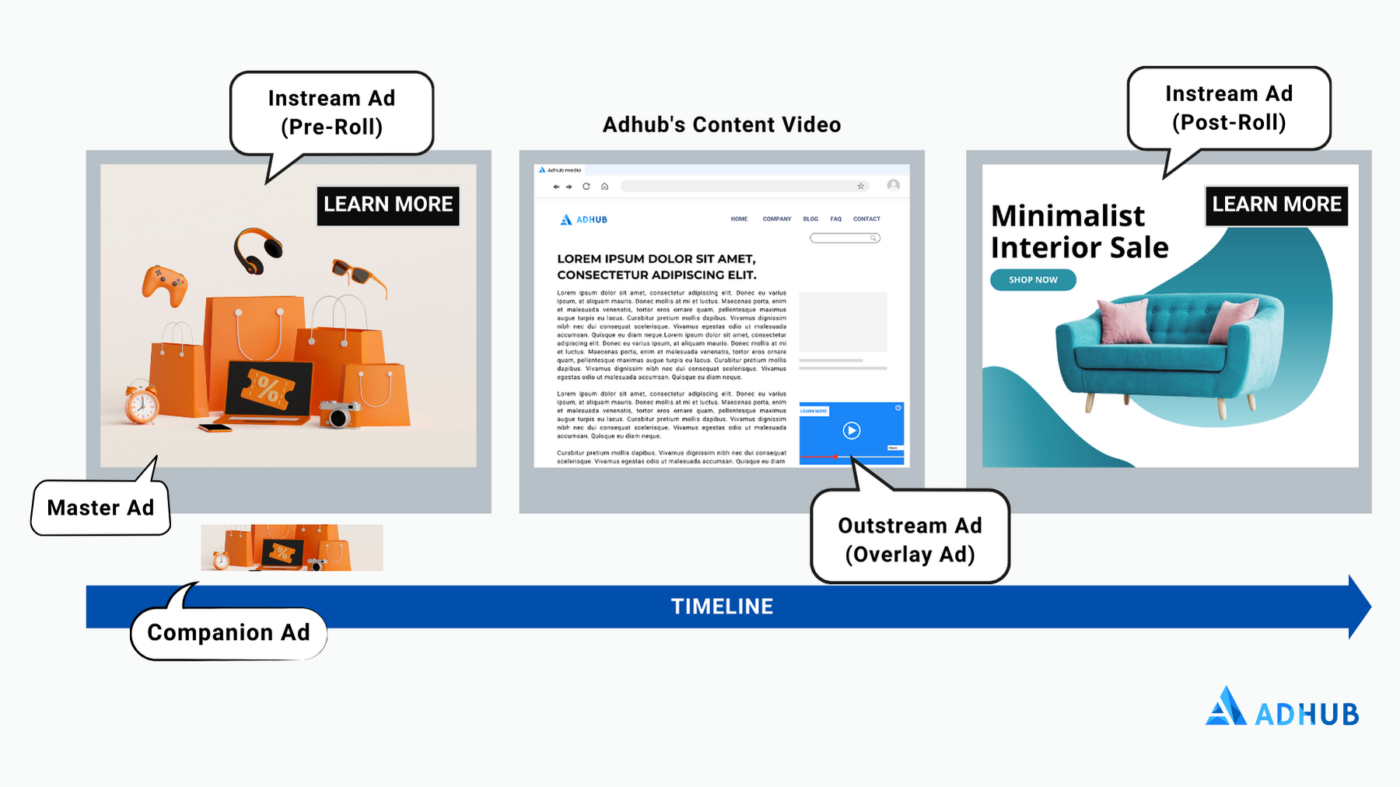Display ads may have dominated the advertising ecosystem for long. But now, with video ads in the picture, they might not be as impactful as before. The reason is simple-video ads attract more attention. It’s a powerful storytelling medium that can be sticky to user movement. This means huge revenue potential for publishers to leverage.
Before diving into creating your own video ads, let’s master the basics – video ad formats. Understanding these definitions is crucial for maximizing your earnings.
This guide will break down the different video ad types available, helping you leverage them for optimal performance.
1. Types of Video Ads for your inventory
First thing first. Before setting up video ads, you must know what type of ad you want to run. You can serve three types of video ads:
- Instream ads – Pre-roll, Mid-roll, and Post-roll (or Accompany content)
- Outstream – Overlay, Non-overlay, standalone (Outstream, in picture,…)
- Companion ads.
Let’s Explore The Three Popular Types of Video Ads

Instream Ads
Instream ads are the most common form of video ads, which alternate between before, during, or after the video. Usually, they can’t be canceled, but some ad servers allow them to be skippable after a certain amount of time.
- Pre-roll: This ad plays before the main video content starts.
- Mid-roll: This ad appears during the video, often during natural breaks in the content.
- Post-roll: This ad plays after the main video content ends.
Outstream Ads
Unlike instream ads, outstream ads do not interrupt the video playback. They are displayed alongside the user’s journey on your page, allowing viewers to engage with the video and the ad simultaneously.
- Overlay Ads: These ads are typically displayed as a transparent layer over the video content, often in the bottom portion of the screen. They are often interactive and can include calls to action.
- Non-Overlay Ads: These ads appear as companion ads alongside the video player, similar to traditional display ads. They do not obstruct the video content.
Companion Ads
Companion ads are display ads that accompany video content. They are typically displayed near the video player or within the page layout. These ads provide additional opportunities for advertisers to reach viewers and can complement the video ad message.
2. Prerequisites for Serving Video Ads
To ensure smooth video ad delivery on your website, there are a few technical requirements to consider:
- Website Security: Your website must be accessible via both HTTP and HTTPS protocols.
- Video ad container: You really need a place where you can display video ads. Usually, you can leverage the content video available in the articles, a standalone player (no content/background video needed), or just simply a picture in that page. You can check this article for Adhub blog for a better view of what kind of ad placeholder that you may find interesting.
- Ad tag provider party: Ad tag is the most important key of the video ad serving process. It plays as a mediator between advertisers and publishers, from demand to displaying ads.
3. Key Strategies for Improving Video Ad Performance
Video ad performance refers to whether an ad is seen by users, the fill rate as well as the bidding range that slot is getting offered from advertisers.
Let’s have a look at some key points that help you boost your video ad revenue.
Contextual Targeting: Aligning Ads with Relevant Content
When an ad is contextually relevant to the consumed content, viewers are more likely to engage with it, resulting in higher viewability and recall.
Contextual targeting ensures that ads are served on videos that resonate with the viewer’s interests. This boosts the chances of engagement, as users are more likely to pay attention to an ad that complements what they’re already watching.
Real-Time Viewability Tracking
Tracking real-time data helps you find out if an ad is being displayed in a viewable position on the screen when it is served. Therefore, you can make immediate adjustments to placements to ensure your ad is visible and engaging to the user. Real-time insights can also help pinpoint the highest-performing inventory, allowing you to optimize your ad strategy for better results.
- Track performance: Understand which videos are delivering the most viewable impressions.
- Optimize placements: Adjust ad positions to maximize visibility and engagement.
- Improve ROI: Focus on high-performing inventory for better campaign results.
Maximize Content Completion Rates
The longer a viewer watches a video, the higher the chances they will engage with the ad and remember the brand. Content completion rates are an important factor in video ad viewability. Videos that are watched to completion drive better ad recall and brand favorability.
To boost content completion, Adhub’s Video player solution can help you increase the viewability stat. We increase viewers’ attention for a longer period via sticky video features, which will generate higher viewability and engagement for your ads. Additionally, we optimize video ads to be short, compelling, and relevant to the content to encourage full viewing.
Use Analytics for Continuous Optimization
Knowing which videos are delivering the highest viewability rates and engagement helps you optimize ad placements and adjust your strategy for better results.
Detailed reporting on viewability rates, completion rates, and engagement levels allows you to continuously refine your inventories. For example, with Adhub’s platform, video ads can generate multiple metrics that can give you a better view of how your inventories and traffic are doing, like viewable impressions, active viewable time, drop-off rate,…
Wrapping Up
By leveraging the correct formats at the exact placement can help maximize value from your traffic. At the same time, using the right tools to support these strategies can make a huge difference.
If you want to learn more about how Adhub Media can support your video ad strategies, contact us right away.

